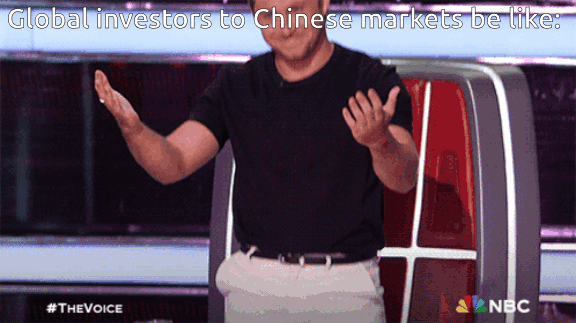Asia Tea Time - Cup 48 ☕
This week I talk inflows into Emerging Market ETFs, understanding the risks of REITs and a tech outage at McDonald’s outlets in Asia.
Macro in Asia
Emerging Market ETFs post new record inflows in February

Exchange-traded funds (ETFs) that track Emerging Markets (EMs) set a new record of inflows in February, attracting US$28.2 billion of new money during the month.
The vast majority of these inflows into EM ETFs were focused on domestic Chinese equity ETFs.
Why it’s happening
- Chinese stocks saw a monster rebound in February, with the Shanghai Composite Index rising nearly 10% for the month while Hong Kong’s Hang Seng Index rose over 8%.
- China’s “National Team” of state-run funds have been buying domestic Chinese stocks in large amounts in an attempt to support prices and boost investor sentiment.
- A lot of global institutions and hedge funds have also been moving back into Chinese stocks as the rally continues.
Why it matters
- China’s kind of big. So big that it makes up a sizeable chunk of any Emerging Market ETF.
- Just take the MSCI Emerging Markets Index – which is used as a benchmark for a wide swathe of EM ETFs. China is its largest country exposure, with nearly 26% of the index dedicated to the world’s second-largest economy.
What’s next?
- Watch whether these inflows continue – and for how long – given China’s indebted property sector isn’t out of the woods yet.
Tim’s Take
- China has been a big topic of discussion for global investors as the question of “how much lower can it go?” consistently asked of its stock markets
At this point in time, a definitive answer to that question is still very much up in the air.
Besides that, the structure of EM ETFs also shines a light on how much of an outsized influence China has on EM indices.
While China makes up over a quarter of the big EM indices, at one point China was close to 40% of the index. It also shows investors the dangers of investing in emerging markets as a homogenous entity.
Mexico is going to be very different to China, which is different to India. As a result of this, many institutional and professional investors are starting to carve out dedicated exposure to China.
For example, the iShares EM ex-China ETF completely excludes China from its investment mandate.
That way, investors can better control their risk exposure to China – and its politics – and decide when and how they want to increase or decrease their holdings in China.
- So while the stock markets in China have rallied, the bigger story here is whether this rally is sustainable or if the broader repositioning of long-term strategies from institutions (away from China and towards other EMs) continues.
Tim’s money tip of the week

When we think about REITs, we think of dividends and income. First off, though, we think of higher yields because many REITs – particularly in Singapore – can provide dividend yields of between 5-7%.
While that’s juicy, we should also be cognisant of the fact that REITs’ whole business model is built on issuing debt.
Their legal and business structure also impacts the sustainability of these dividend payouts.
If we view REITs as a traditional stock or company, it’s a simplified approach – but not exactly untrue – to say that Singapore REITs have a dividend payout ratio of 90%.
That’s because they’re legally required, under the preferable tax structure of REITs in the city state, to pay out 90% of their net property income (NPI) as distributions to shareholders.
The problem with that is that when interest rates rise, capital becomes more costly, and net asset values (NAVs) of REITs’ properties fall, this can result in dividend cuts or even outright dividend suspensions.
A lot of shareholders in Singapore of S-REITs that own overseas assets – particularly US office properties – have experienced these dividend suspensions.
So, while we can always have REITs as part of our portfolio, we should also be completely clear on the risks to dividend sustainability given their structure.
If we do have S-REITs in our portfolios, I’ve always been a fan of buying the biggest and strongest ones that also have the best long-term track record of uninterrupted/consistently growing distributions.
Story of the week

McDonald’s suffered a widespread system outage this past week that disrupted operations in Singapore, Japan, and China.
Self-service kiosks that usually help speed along queues were showing blank black screens. A McDonald’s spokesperson said the company was investigating and it wasn’t related to a “cybersecurity event”.
While we shouldn’t be alarmed – since the benefits of tech far outweigh the drawbacks – it does highlight the potential disruption that outages can bring to businesses.
